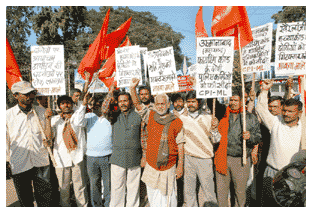
Dalit Rage Boils Over in Maharashtra
What eventually led to breaking the deceptive calm after the horrific rape and massacre of the Bhotmange family in Kherlanji? What is causing Dalits of Maharashtra to repeatedly hit the streets in militant protests? The police’s deliberate delay, its obvious attempt to weaken the case and deny the gangrape and cover up the massacre, the insensitive
coverage of the local media and the cold shoulder by the national media – all contributed to building up the resentment. Seemingly al of a sudden, the resistance burst out. The police response only confirmed and intensified the sense of alienation and injustice.
Amazingly, Nagpur’s police chief put the protestors themselves in the dock, alleging that while they were ‘apparently angry over the delay in investigation’, he himself ‘smelt a deeper conspiracy (by Naxalites) against the police’!There were combing operations all around Nagpur; young men and women from Dalit localities were subjected to indignities and humiliations.
Round one of the protests simmered down, but wasn’t far below the surface. It took the Kanpur incident to boil up again – even more intense and militant. Clearly, the anger was directed against theState; its callous
A five member AIPWA team visited Pimpri near Pune on December 4, to investigate the outburst of protests against the desecration of the Ambedkar statue. The team comprised of Medha Thatte, Mukta Manohar, Shashi Yadav, Madhavi Sarkar, and Saroj Chaubey. They spoke to Maya Sawant, Shobha Lode, Malti Waghmare and other women of the Shramik Mahila Morcha, the organization which on December 2, had held a protest march of hundreds of women, in which AIPWA leaders also participated. |
and systematic institutions of discrimination. When limbs are chopped off statues of Ambedkar, can anyone help but think that it’s a chilling warning of what can be done to the likes of Bant Singh? Punjab and Maharashtra – two Congress-ruled states,both marked by agrarian crisis, have been witness to horrific crimes against Dalits. The Maharashtra police’s approach over Kherlanji is all too similar to its reaction to the Mumbai blasts and Malegaon blasts. Be it the Muslims or Dalits – the combing, the wholesale arrests, the branding of the entire community as potentially terrorist unless ‘proved otherwise’ – all inspire a sense of déjà vu.
The despair and intensifying protests of the farmers of Vidarbha is matched by the militancy of the resistance by the Dalits of the same region. They toll a warning bell for the Congress-NCP Government, and have forced the RPI to put a distance between itself and the NCP.
A CPI(ML) Investigation Team, led by Party Politburo Member Com. Akhilendra Pratap Singh visited Kherlanji on Dec. 1. The team found that a land dispute lay behind the massacre. The neo-rich contractors and mafia (from Kunbi, Teli, Kalra and Gond communities of MBC and adivasi origin) are the main accused, and the main accused are known to be close to influential leaders of BJP, Shiv Sena, and NCP. In view of the declining fortunes of Shiv Sena and BJP, NCP and Congress are making desperate efforts to win them over to their fold. Kherlanji is a reminder that the issue of atrocities dalit cannot be seen as simply one of ‘upper’ versus ‘lower’ castes. The phenomenon of the emergence of kulaks and mafia forces amongst the backward castes, and the violence wreaked by them on agrarian labourers and dalits is no longer confined to Bihar and UP – it is a nationwide phenomenon. The role of the SHO, Dy. SP and doctor in Kherlanji in protecting the culprits also indicates the class differentiation among the dalits. The entire episode also served to expose the bankruptcy of the established ‘Dalit’ political parties, in contrast with the militancy of the spontaneous protests of the Dalit people. |